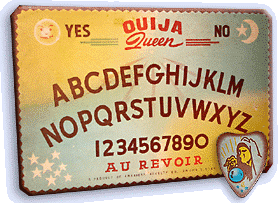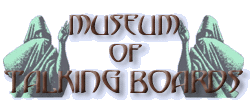
”Rest your fingers lightly
but firmly on the SUPERTABLE, allowing it freely to move
over the board in all directions. The two people should
maintain a continuous contact with the SUPERTABLE, and the
SUPERTABLE should be in constant touch with the OUIJA
QUEEN. If you fail to get results in playing the board, it
is at no time the fault of the board. It is merely that the
so-called Psychic force is undeveloped in the operators. We
make no claims of scientific or supernatural
qualities.”
The early 1940's brought a remarkable proliferation of talking boards as manufacturers flooded the market with colorful and unique designs. We can't say why this happened with any certainty. One thought is that Ouija boards sell better during times of war because people are looking for hope and answers. Desperation turns people towards religion and the supernatural and faith based solutions. Another answer is that it may have been a wartime fad with the forties generation discovering Ouija boards for the first time. Maybe it was a combination of both the war and the fad. Whatever the reasons, the companies are long gone having only lasted for a few years and there is no one left to ask. Occasionally, we get lucky. This is the story of American Novelty Company.
 We know little about
James Acuff except for his vision. He created a new Ouija
board and he believed it was good enough to market
nationally. There were already Ouija boards on the market
but there was always room for one more, particularly if the
price was right. Acuff called his board the Ouija Queen and
the layout was much like any other Ouija board. There was
the sun and the moon, the words YES and NO and AU REVOIR,
and a sprinkling of stars in the corners. AU REVOIR instead
of GOOD-BYE might have been a nice touch except that the JM
Simmons Company had been using it on a Ouija board since
1918. And when it came to Ouija boards, leading
manufacturer William Fuld absolutely dominated the American
scene. James Acuff had a vision but it wasn't very original
and it certainly wasn't timely considering the wartime
shortage of wood. Acuff was also hugely underfunded. Had he
consulted his Ouija Queen, the response might have been,
“Conditions poor. Try again later.”
We know little about
James Acuff except for his vision. He created a new Ouija
board and he believed it was good enough to market
nationally. There were already Ouija boards on the market
but there was always room for one more, particularly if the
price was right. Acuff called his board the Ouija Queen and
the layout was much like any other Ouija board. There was
the sun and the moon, the words YES and NO and AU REVOIR,
and a sprinkling of stars in the corners. AU REVOIR instead
of GOOD-BYE might have been a nice touch except that the JM
Simmons Company had been using it on a Ouija board since
1918. And when it came to Ouija boards, leading
manufacturer William Fuld absolutely dominated the American
scene. James Acuff had a vision but it wasn't very original
and it certainly wasn't timely considering the wartime
shortage of wood. Acuff was also hugely underfunded. Had he
consulted his Ouija Queen, the response might have been,
“Conditions poor. Try again later.”
Isadore Chapman of Omaha, Nebraska, had a reputation for honesty, integrity, and fair business dealings. As a partner of Iowa Finance Company, it was his job to find ways to make money during the country's wartime crisis. He faced formidable obstacles, as did many business leaders of his era. His main workforce was at battle leaving the company woefully understaffed. To add to his problems, one of his partners was in the service and the other was recovering from an illness. Chapman wisely decided to expand the personal loan program to include businesses to help keep Iowa Finance afloat. That was a lucky opportunity for James Acuff who desperately needed a business loan for his Ouija Queen enterprise. This need brought the two men together. But Acuff was more the visionary than a businessperson. We don't know the exact amount but we do know this: the loan money from Iowa Finance was gone within a year and Acuff had nothing to show for it. The Ouija Queen had died and that left Isadore Chapman responsible for her burial, or perhaps, her resurrection. With little choice, Chapman elected to take over the rights and to go into the Ouija board business. Although there was no obligation, he promised to pay Acuff royalties if the Ouija Queen returned a profit and after the loan was satisfied.
 Chapman may have
known little about Ouija boards but he knew much about
business. On August 24, 1943, he incorporated the American
Novelty Company in the state of Nebraska solely to
represent the Ouija Queen. He chose a small South Omaha
manufacturing plant, uninvolved in the war effort, to make
his boards. Instead of wood, he picked a cheaper
composition material. Before long, production was in full
force. Chapman used wholesalers to nationally distribute
his Ouija board and he landed large contracts with giant
department store chains Montgomery Ward and Spiegel. His
price to dealers was half of what William Fuld was
charging. But all was not rosy. At first, Montgomery Ward
wouldn't consider American Novelty because it hadn't
existed long enough to establish credit and might not be
able to sustain large orders. That it was Iowa Finance's
sister company didn't matter. But Chapman worked this to
his advantage. He offered an arrangement whereby he would
ship cash-on-delivery to each of the Montgomery Ward
stores. This was a direct benefit to the company in time
and money because the boards didn't have to go to Ward's
central Chicago warehouse first for distribution to
individual outlets. By so doing, Chapman could deliver his
product earlier than promised and know, by the individual
orders, exactly the consumer demand for the boards. Plus,
payment through C.O.D. was much faster than payment through
central headquarters. The retail price to a Montgomery Ward
customer was ninety-eight cents. Sales were very
good.
Chapman may have
known little about Ouija boards but he knew much about
business. On August 24, 1943, he incorporated the American
Novelty Company in the state of Nebraska solely to
represent the Ouija Queen. He chose a small South Omaha
manufacturing plant, uninvolved in the war effort, to make
his boards. Instead of wood, he picked a cheaper
composition material. Before long, production was in full
force. Chapman used wholesalers to nationally distribute
his Ouija board and he landed large contracts with giant
department store chains Montgomery Ward and Spiegel. His
price to dealers was half of what William Fuld was
charging. But all was not rosy. At first, Montgomery Ward
wouldn't consider American Novelty because it hadn't
existed long enough to establish credit and might not be
able to sustain large orders. That it was Iowa Finance's
sister company didn't matter. But Chapman worked this to
his advantage. He offered an arrangement whereby he would
ship cash-on-delivery to each of the Montgomery Ward
stores. This was a direct benefit to the company in time
and money because the boards didn't have to go to Ward's
central Chicago warehouse first for distribution to
individual outlets. By so doing, Chapman could deliver his
product earlier than promised and know, by the individual
orders, exactly the consumer demand for the boards. Plus,
payment through C.O.D. was much faster than payment through
central headquarters. The retail price to a Montgomery Ward
customer was ninety-eight cents. Sales were very
good.
Although it was a great success, American Novelty ended production of the Ouija Queen after the war. The company continued until 1950 with various Halloween products, small stone figurines, and statuettes, but none approached the success of the Ouija Queen. During production, there were two Ouija Queen models: a brown and yellow themed board and a multicolored blue, yellow and red board (see pictures). Many survive because of the large production runs and can be found in antique stores, second hand shops and online on eBay.
After American Novelty Company, Isadore Chapman was able to devote his full time to the finance business, which he considered his real calling. Ouija Queen creator James Acuff received his promised royalties and produced a look-alike board called the Ouija Genii with Boland Manufacturing Company of Winona, Minnesota. Iowa Finance Company became a subsidiary of AVCO Corporation in 1965.
Many thanks to Lawrence Chapman, the son of Isadore Chapman, and Evelyn Bundy Hill of Iowa Finance Company and American Novelty Company for a wonderful contribution to the Museum of Talking Boards.
